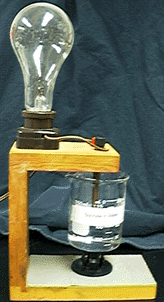 | To begin we looked at the conductivity of a sample of deionized water (water with little or no ions) which could be viewed as pure water. Looking at the image on the left the light bulb is not glowing. This can be explained in terms of the nature of the species in the sample of water. That the light does not glow suggests there are no ions in the sample. This is an important measurement to establish subsequent measurements in deionized water. Any observed conductivity will due to the presence of the solute. |
Next we measured the conductivity of an aqueous solution of sodium chloride. Here the light bulb glows brightly indicating the presence of ions in the solution. The ability of an aqueous solution of sodium chloride to conduct electricity is characteristic of a strong electrolyte. How do we express this observation using a chemical equation?
Soluble ionic compounds are also strong electrolytes, i.e., behave the same way as sodium chloride...forming ions when dissolved in water. How do we know whether an ionic compound dissolves in water? That is determined by experiment. A Solubility Table summarizes the experimental observations of the solubility behavior of a large group of ionic compounds. We'll discuss a Solubility Table shortly. | .gif) |
 | When we tested the conductivity of an aqueous solution of sucrose the light bulb did not glow. This type of behavior is characteristic of a nonelectrolyte. No ions in this solution, yet the sucrose dissolved. How do we write a chemical equation in this case?
In general soluble covalent compounds do not dissociate into ions when dissolved in water. |
The last solution which studied was a solution containing acetic acid, HC2H3O2. Notice the light bulb glows weakly, it is not as bright as in the case of the solution of sodium chloride. The conclusion would have to be that there are not as many ions in aqueous solution of acetic acid as there is in an aqueous solution of sodium chloride. Assuming the concentration of acetic acid and sodium chloride are the same in the two solutions the dimmer light suggests acetic acid forms fewer ions in solution. Other experimental evidence supports this conclusion, acetic acid is a weak electrolyte.The chemical equation which describes the behavior of a weak electrolyte in aqueous solution is,
|  |
Mentioned earlier was the Solubility Table. A Solubility Table summarizes the solubility behavior of a large group of ionic substances. How to interpret a Solubility Table?

We can use the Solubility Table to determine whether an ionic compound exist as ions in aqueous solution (soluble) or as a solid (insoluble). Once we know the compound we use the Solubility Table to determine its solubility.
For example, consider the following compounds; NaCl, BaSO4, NaC2H3O2, and CaS. Determine the solubility in water for these ionic substances.
NaCl (all chlorides are soluble except...) SOLUBLE;
BaSO4 (all sulfates are soluble except...) INSOLUBLE;
NaC2H3O2 (all sodium compounds are soluble) SOLUBLE;
CaS (all sulfides are insoluble...) INSOLUBLE
We'll also use the information in a Solubility Table to help identify the phase of ionic substance in a chemical equation. The chemical reaction types where the Solubility Table is important are;
Lets consider a double displacement reaction problem;
Write the formula and identify the phase for the product(s) and balance the following reaction.
Na2SO4(aq) + CaCl2(aq) --->
Since this is a double replacement reaction we can write the formulas of the products by exchanging the cations and anions. When you do this remember to keep track of the individual charges on the cations and anions.
Na2SO4(aq) + CaCl2(aq) ---> CaSO4(?) + 2NaCl(?)
Now we'll use the Solubility Table to predict the phases of the products. According to the table CaSO4 is INSOLUBLE and NaCl is SOLUBLE.
Na2SO4(aq) + CaCl2(aq) ---> CaSO4(s) + 2NaCl(aq)
Let's consider another example, this one from our text (4.39c).
Write the formula and identify the phase for the product(s) and balance the following reaction.
AgNO3(aq) + Na2CO3(aq) --->
Since this is a double replacement reaction we can write the formulas of the products by exchanging the cations and anions. When you do this remember to keep track of the individual charges on the cations and anions.
2AgNO3(aq) + Na2CO3(aq) --->Ag2CO3(?) + 2NaNO3(?)
Now we'll use the Solubility Table to predict the phases of the products. According to the table Ag2CO3 is INSOLUBLE and NaNO3 is SOLUBLE.
2AgNO3(aq) + Na2CO3(aq) ---> Ag2CO3(s) + 2NaNO3(aq)
Here is a Shockwave animation using the Solubility Table.
Na2SO4(aq) + CaCl2(aq) ---> CaSO4(s) + 2NaCl(aq)
To change the above equation to the ionic equation the aqueous ionic substances must be written as ions;
2Na+(aq) + SO42-(aq) + Ca2+(aq) + 2Cl-(aq) ---> CaSO4(s) + 2Na+(aq) + 2Cl-(aq)
Now we'll cancel all species common to both sides of the equation;
2Na+(aq) + SO42-(aq) + Ca2+(aq) + 2Cl-(aq) ---> CaSO4(s) + 2Na+(aq) + 2Cl-(aq)
The final net ionic equation is;
SO42-(aq) + Ca2+(aq) ---> CaSO4(s)
The second equation we'll convert is;
2AgNO3(aq) + Na2CO3(aq) ---> Ag2CO3(s) + 2NaNO3(aq)
To change the above equation to the ionic equation the aqueous ionic substances must be written as ions;
2Ag+(aq) + 2NO3-(aq) + 2Na+(aq) + CO32-(aq) ---> Ag2CO3(s) + 2Na+(aq) + 2NO3-(aq)
The net ionic equation is;
2Ag+(aq) + CO32-(aq) ---> Ag2CO3(s)
Here is a Shockwave animation using the Activity Series